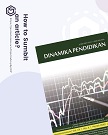How to Measure the Entrepreneurial Competences of SME’s Using the Rasch Model?
(1) Economic Education Study Program, Faculty of Teacher Training and Education, Universitas Siliwangi
(2) Economic Education Study Program, Faculty of Teacher Training and Education, Universitas Siliwangi
(3) Accounting Study Program, Department of Business and Finance, Faculty of Vocational Studies, Universitas Negeri Yogyakarta
Abstract
This study focused on measuring the entrepreneurial competence of MSME actors in the post-pandemic period. A purposive sampling technique was utilized to recruit the respondents. The respondents encompassed perpetrators, owners, and managers of SMEs assisted by the Indonesian Business Development Services Association (ADBSI) given government assistance (N=100). Technically, the Rasch Model was employed to measure Entrepreneurial competency since it is assumed to be the most appropriate model for quantitative data analysis in the field of human sciences. It enables the researchers to produce ordinal data. Tests with Winstep were carried out on entrepreneurial competency data in the pandemic era. They covered: summary statistics, item measures and Wright maps, item (column) fit order, item test (dimensionality), rating (partial–credit) scale test, differential item functional (DIF) test and probability value. The results of the study proved that the applied entrepreneurial competency instrument indicated good persons, Cronbach Alpha, and item reliability. The personal reliability coefficient obtained a value of 0.88. An item of 0.76 revealed good and fairly good. The results of one of the instruments were considered the most essential aspects related to entrepreneurial competencies. The competencies should be possessed by students to face the post-pandemic business competition.
Keywords
Full Text:
PDFReferences
Abdaziz, A., Jusoh, M. S., & Amlus, H. (2014). Construct Validity: A Rasch Measurement Model Approaches. Journal of Applied Science and Agriculture, 9(September), 7–12.
Al Mamun, Abdullah, Muniady, Rajennd A/L, Hery, Mohd Asrul Hery, Noorshella, (2018) "Effect of economic vulnerability on entrepreneurial competencies among Malaysian micro-entrepreneurs", Asia Pacific Journal of Innovation and Entrepreneurship, https://doi.org/10.1108/ APJIE-03-2018-0013
Baghaei, P. (2014). The Rasch Model as a Construct Validation Tool. Rasch Measurement Transactions, 22(1).
Brinkman, W.-P. (2009). Design of a Questionnaire Instrument. Handbook of Mobile Technology Research Methods, December, 31–57.
Catriana, Elsa. (2020). Terpukul Corona, Ini 5 Keluhan Para Pelaku UMKM, retrieved from https://money.kompas.com/read/2020/03/27/190000026/terpukul-corona-ini-5-keluhan-para-pelaku-umkm.
Ghazali, N. H. M. (2016). A Reliability and Validity of an Instrument to Evaluate the School-Based Assessment System: A Pilot Study. International Journal of Evaluation and Research in Education (IJERE), 5(2), 148–157.
Jusoh. (2018). Construct Validity for Measuring Entrepreneurial Readiness Among Malaysian Higher Education Students: A Stochastic Measurement Model Approach. In MATEC Web of Conferences 150, (Vol. 150, pp. 1–4).
Dahiya, Kapil., Ali Potia, Resil Das, Denny Praseco, (2020). Survey: Indonesian consumer sentiment during the coronavirus crisis, McKinsey & Company Survey, retrieved from https://www.mckinsey.com/business-functions/marketing-and-sales/our-insights/survey-indonesian-consumer-sentiment-during-the-coronavirus-crisis.
Kijkasiwat, P., Wellalage, N. H., & Locke, S. (2021). The impact of symbiotic relations on the performance of micro, small and medium enterprises in a small-town context: The perspective of risk and return. Research in International Business and Finance, 56 (January), 101388. https://doi.org/10.1016/j.ribaf.2021.101388
Liedholm, C.E. and Mead, D.C. (2013), Small Enterprises and Economic Development: The Dynamics of Micro and Small Enterprises, Routledge Studies in Development Economics, Routledge, Abingdon.
Man, T. W., & Lau, T. (2000). Entrepreneurial competencies of SME owner/managers in the Hong Kong services sector: A qualitative analysis. Journal of Enterprising Culture, 8(3), 235–254
Man, T. W., Lau, T., & Chan, K. F. (2002). The competitiveness of small and medium enterprises: A conceptualization with a focus on entrepreneurial competencies. Journal of Business Venturing, 17(2), 123–142.
Man, T. W. Y., Lau, T., & Snape, E. (2008). Entrepreneurial Competencies and the Performance of Small and Medium Enterprises: An Investigation Through a Framework of Competitiveness. Journal of Small Business & Entrepreneurship, 21(3), 257-276. doi:10.1080/08276331.2008.10593424.
Mohajan, H. K. (2017). Two Criteria for Good Measurements in Research: Validity and Reliability. Annals of Spiru Haret University, 17(3), 1–32.
Othman, N. B. (2014). Assessing Construct Validity and Reliability Of Competitiveness Scale Using Rasch Model Approach. The 2014 WEI International Academic Conference Proceedings, 113–120.
Osterlind, S. J. (1983). Test item bias. Beverly Hills, CA: Sage Publication Inc.
Rahmawati, E. (2019). Developing instruments of teacher's perception of critical thinking in elementary school. Journal of Education and Learning (EduLearn), 13(4), 559–566. https://doi.org/10.11591/edulearn.v13i4.13232
Ratten, V. (2016), “Female entrepreneurship and the role of customer knowledge development, innovation outcome expectations and culture on intentions to start informal business ventures”, International Journal of Entrepreneurship and Small Business, Vol. 27 Nos 2/3, pp. 262-272.
Setiawan, B., Panduwangi, M., & Sumintono, B. (2018). A Rasch analysis of the community’s preference for different attributes of Islamic banks in Indonesia. International Journal of Social Economics, 45(12), 1647–1662. https://doi.org/10.1108/IJSE-07-2017-0294
Sumintono, B. (2014). Model Rasch untuk Penelitian Sosial Kuantitatif. Makalah Kuliah Umum Di Jurusan Statistika, ITS Surabaya, 21 November 2014. https://doi.org/10.1002/rcm.1134
Sumintono, B. (2016). Aplikasi Pemodelan Rasch pada Asesmen Pendidikan: Implementasi Penilaian Formatif (Assessment For Learning). Makalah Dipresentasikan Dalam Kuliah Umum Pada Jurusan Statistika, Institut Teknologi Sepuluh November, Surabaya, 17 Maret 2016., March, 1–19. http://eprints.um.edu.my/15876/1/ITS_rasch_model_asesment_for_learning.pdf
Undang Undang Republik Indonesia Nomor 20 Tahun 2008 Tentang Usaha Mikro, Kecil dan Menengah.
Plumeyer, A., Kottemann, P., Böger, D., & Decker, R. (2019). Measuring brand image: a systematic review, practical guidance, and future research directions. Review of Managerial Science, 13(2), 227–265. https://doi.org/10.1007/s11846-017-0251-2
van Buuren, S., & Wijnmalen, D. J. D. (2015). Measuring Psychosocial Impact of CBRN Incidents by the Rasch Model. Journal of Applied Measurement, 16(3), 242–250
Wu, M., & Adams, R. (2007). Applying The Rasch Model To Psycho-Social Measurement A Practical Approach. Educational Measurement Solutions.
Zainol, Noor Raihani, and Al Mamun, Abdullah, (2018) "Entrepreneurial competency, competitive advantage and performance of informal women micro-entrepreneurs in Kelantan, Malaysia", Journal of Enterprising Communities: People and Places in the Global Economy, https://doi.org/10.1108/ JEC-11-2017-0090
Zile-Tamsen, C. Van. (2017). Using Rasch Analysis to Inform Rating Scale. Research in Higher Education. https://doi.org/10.1007/s11162-017-9448-0
Zohrabi, M. (2013). Mixed Method Research: Instruments, Validity, Reliability, and Reporting Findings. Theory and Practice in Language Studies, 3(2), 254–262. https://doi.org/10.4304/tpls.3.2.254-262
Refbacks
- There are currently no refbacks.

This work is licensed under a Creative Commons Attribution 4.0 International License.


.png)

.png)





